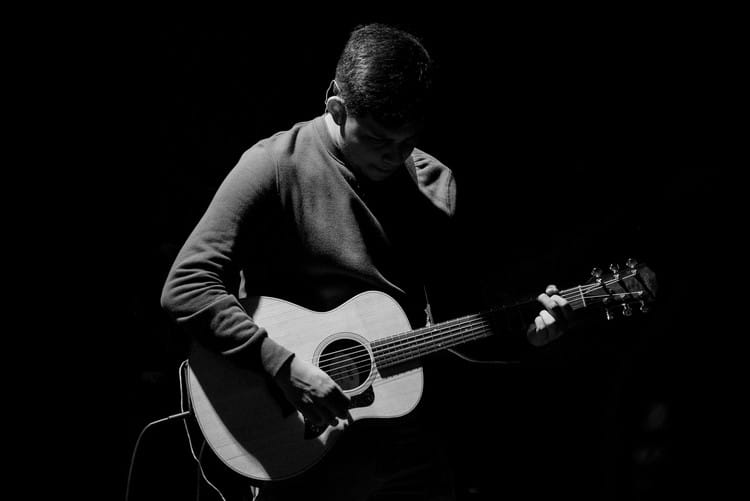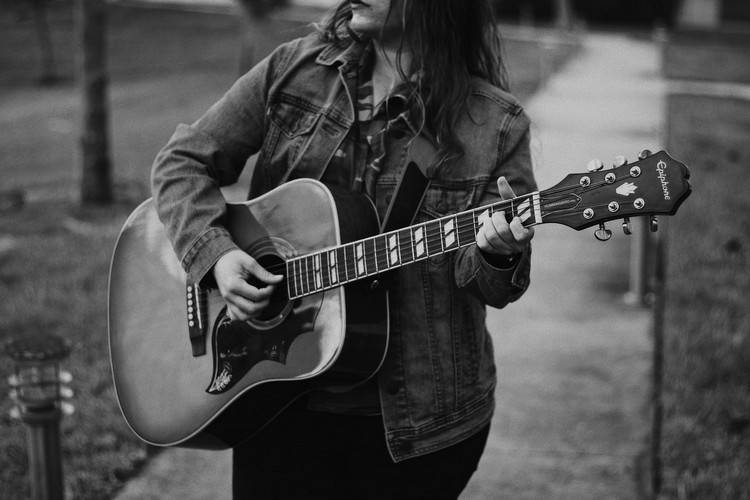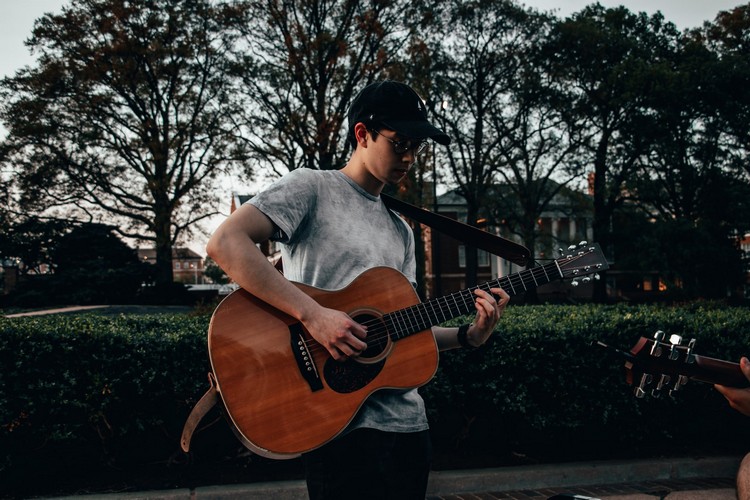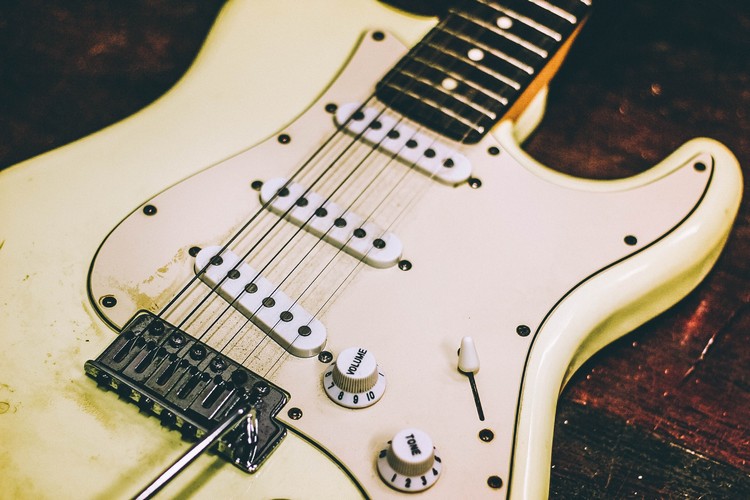Let’s learn how to read and understanding guitar tabs with ease!
Over 250,000 guitar-learners get our world-class guitar tips & tutorials sent straight to their inbox: Click here to join them
In this free lesson you will learn…
- The principles of guitar tablature
- How to approach guitar tabs for instant progress and success
- The best way to learn to read tablature
- How tablature is different than traditional notation
Let’s Learn To Read Guitar Tabs
Tablature is one of the many fundamentals that we need to learn to wrap our head (and hands) around as beginner guitarists.
Although it looks a little intimidating up-front, there’s not much to fear when it comes to learning one of the best methods for communicating guitar music.
Guitar tabs are ideal for the beginner guitarist who is looking to learn the ins and outs of the instrument.
Although tablature doesn’t convey as much performance information as traditional notation, it gives us more than enough to learn just about any piece of music all the same.
In this lesson, we’re going to teach you how to read tabs in order to make learning music that much easier.

“Okay, but how different are guitar tabs from traditional notation? Which one is more important to learn?”
If you’re a beginner guitarist, you don’t need to fuss over learning to read traditional notation just yet.
That’s not to say that you should never learn it (knowledge is power, after all), but it’s not a priority at the moment.
Guitar tabs force us to use our ears to determine things like note expression, rhythm and tempo among other things. This makes them ideal for newer guitarists looking to get off on the right foot.
Now let’s dive into everything we need to know.

Understanding The Fundamentals Of Guitar Tabs
Tablature looks a bit weird at a glance, so let’s break it down.
The first thing we need to understand is that we read tablature as follows:
High E
B
G
D
A
Low E
This may seem counter-intuitive to some, but you get used to it rather quickly.
Think of it like this: If you were to lay your guitar down flat in front of you, this would be the perspective you would have of your guitar strings.
Make a bit more sense now?
Good, let’s keep going.

There are three main things you have to look out for when reading guitar tabs:
- Notes vs Chords – Notes will display themselves as fret numbers in sequence one at a time, whereas chords will appear as a group of stacked numbers altogether.
- Tempo & Rhythm – These musical principles are not implied with guitar tabs, meaning you’ll have to use your ears to figure out things like speed and strumming patterns.
- Performance Symbols – Although tempo and rhythm aren’t implied, certain techniquers are. Be on the lookout for symbols (explained below) that will point you in the right direction for how to express certain passages of notes.
Now that we’ve got the main principles out of the way, let’s explore the symbols we’ll find when reading tablature.

Download our lead guitar cheat-sheet to make things easier
It's hard to understand which scales work with which keys.
So we created a cheat-sheet! A key and scale-finder that you can use again and again.

Get your personalised guitar-learning plan 🎸
Get a custom guitar-learning plan here: Click here for GuitarMetrics™
World-Class Guitar Courses 🌎
Learn from the world's best guitar educators: Click here for our guitar courses
Symbols Used In Guitar Tabs
Tablature helps point us in the right direction for performance in a couple different ways, but mostly in ways surrounding our technique.
There are a few techniques we need to take note of that pop up often when reading guitar tabs:
- Hammer-ons – Represented with an “H”, this technique indicates that we move from one note to the next by “hammering” our finger to the next note rather than picking it
- Pull-offs – The opposite of a hammer-on, pull-offs have us pull one finger off a string to transition the note to the finger behind it. Pull-offs are represented with a “P”

- Sliding Up & Down – Another common technique, sliding up is typically shown with a “/” where sliding down is shown with a “\”. These symbols indicate for you to slide your finger from one position to the next
- Picking – Many folks who write guitar tabs online will represent their suggested picking patterns with a combination of arrows such as “ /\ /\ /\ /\ \/ \/ \/ \/” and so on in order to show the reader which way to point their pick

- Muting – Some strings or string sets will be blocked off with “X”s in order to indicate that these strings should either be struck while muted or simply not played at all
- Palm Muting – A common and expressive technique, palm muted passages are represented with a “PM ——-” across the length of whatever needs to be palm muted. Place the side of your hand across the bridge to make it easy.
Pro Tip: It’s important to make note of these symbols, as you will see them extremely frequently when reading guitar tabs – especially ones that you find online.
For a more in-depth lesson on tablature symbols, click here.

How Do We Understand Timing In Guitar Tabs?
Timing can be a difficult thing to figure out, especially when we start out playing guitar.
It’s stressful to look at a piece of music using guitar tabs and wonder how to play everything, if not completely straight-ahead and note-by-note at a consistent pace.
This is the one major pitfall with reading tablature – that we have no direct way of reading the rhythm and timing of the song.
There are some solutions, such as Guitar Pro software which will play the guitar tabs in question back for you in real time, but that is also a paid option.
This is where our ears come into play in a big way, so let’s talk about listening for a minute.

The guitar heroes of old all tell stories of learning to play guitar while listening to old vinyl records, and how much it helped them to become the guitarist they wanted to be.
This trend hasn’t died, and it never will.
Learning by ear is an incredible way to help you accomplish more with guitar tabs in the same amount of time it would take you to read a piece of sheet music (if not a little longer).
Listening is your greatest tool, as it helps you uncover all types of nuances in another musician’s playing. It’s important to learn using tablature, but using your ears will push you forward that much faster.
Now, let’s get down to the fundamentals of reading guitar tabs.

Reading Chords VS Notes
It’s pretty easy to tell the difference between notes and chords in tablature, but it’s how we approach them that makes musical passages easier to play.
Individual notes that are meant to be played one at a time will be shown in sequence one after the next, where chords and groups of two or more notes will be shown as stacked on top of one another.
To read these is fairly straightforward in theory, but to play them right takes a bit of practice.
Scroll down for a pro tip on articulating with your pick when playing musical passages with combinations of notes and chords.

Here’s the thing:
When we start out reading guitar tabs, we’re mostly learning to play single-note passages with the occasional chord sprinkled in.
But we can guarantee you one thing:
It doesn’t stay like that for long.
As we progress on guitar, tablature becomes an increasingly intricate device for reading music, and it’s important to pay attention to how things are presented to you.
Practising picking exercises will help you learn to articulate passages more easily when it comes to reading combinations of string groupings.
If you want 5 essential guitar exercises with guitar tabs, click here and we’ll get you sorted.
We’ve got some more exercises below to get you off on the right foot, so let’s keep going.

A Quick Exercise In Reading Guitar Tabs
If we’re going to learn the ins-and-outs of tablature, we’re going to need to grab our guitar and play through some easy examples.
In this first example, we’re going to play a basic chromatic scale to get a feel for reading through guitar tabs with basic left and right hand movement.
The objective of this exercise is to get your eyes moving between the tablature and the guitar so that you can coordinate your hands more easily.
This first exercise is one we all need to know – the chromatic scale.
You’ll see us throw this one around a lot at National Guitar Academy – play it for yourself and find out why.

The big lesson here is the positioning of the fingers across the first four frets.
In order to pull this off with ease, we’re going to want to place our fingers as so:
Index: 1st fret
Middle: 2nd fret
Ring: 3rd fret
Pinky: 4th fret
The other big takeaway here is how we pick across the strings.
Make sure to take on an up-down-up-down approach to picking through this (and all) exercises.
This is called alternate picking, and it will change your life (click the link for a lesson).
Pro Tip: As you learn to navigate the fretboard, it’s important to have your whole hand shift when you move up and down. Avoid trying to make larger stretches work, and opt to move your hand around the fretboard instead.

Learn 12 EASY beginner chords with our popular guide

✅ Stop struggling. Start making music.
✅ Learn beginner-friendly versions of every chord.
This is our most popular guide and it will improve your chord ability quickly! 😎
Get your own personalised guitar-learning plan 🎸
Get a custom guitar-learning plan here: Click here for GuitarMetrics™
World-Class Guitar Courses 🌎
Learn from the world's best guitar educators: Click here for our guitar courses
Reading Melodic Passages Of Guitar Tabs
Okay, so we’ve played a couple straight-forward exercises, but what about melodies and chords?
We need some real-life melodic examples if we want to work out the best ways to read guitar tabs.
So let’s look at the most classic guitar riff example ever:
“Smoke on the Water” by Deep Purple.
This riff gives us a lot to work with because it uses a technique called “double stops” which features the use of two notes on adjacent strings at the same time.
Take a look at the riff below and use a tight picking approach to not pick the strings that you don’t need.

“Smoke on the Water” is a classic tune with a great riff, but it’s also a great exercise in listening to figure out how the song moves.
Click here to listen to the song and listen for the timing and flow of the riff.
Here are a couple things that you can look out for when listening to learn different songs:
- Listen for how the guitarist strikes the strings to replicate the same type of articulation (are they picking hard? Soft? Are they using a pick or fingers?)
- How does the timing work? What feels most comfortable to count? Try and work it out!
- When the guitarist is playing chords, are they playing partial chords or using all six strings?

Guitar tabs aren’t all this easy to play, but that’s why we’ve prepared another list of awesome easy-to-play guitar riffs with tablature included.
If you want to take your ability to read tabs to the next level, click here for 20 easy songs that sound great.
Next, let’s take a look at some resources to help you read guitar tabs more easily.

Recommended Resources & Software
If you’re worried about having to strike out on your own to learn tablature, don’t worry! We’ve got you covered.
The internet is chock full of places to find guitar tabs, but our favourite place by far is Ultimate-Guitar.com.
This website is the biggest library of tablature on the internet, and the best part is that it’s completely community-made!
If there’s a particular song that you’re looking to learn, check this website first. There’s a good chance you’ll find it there.

One of our other absolute-favourite ways to read (and create) guitar tabs is Guitar Pro by Arobas Music.
Although this is paid software, Guitar Pro is an astounding tune for helping guitarists of any level learn music.
Guitar Pro can play any piece of tablature back at any speed you like – this makes it especially helpful for learning more difficult musical passages.
If you’re looking for a free alternative that can do many of the same things as Guitar Pro, check out TuxGuitar.
TuxGuitar doesn’t have the same capabilities as Guitar Pro, but it still has many of the essentials you’ll need to read guitar tabs like a pro.

The Best Ways To Practice Reading Guitar Tabs
The best thing about reading tablature is that we can only get better at it with practice.
Here are a few key things to keep in mind to help you improve your ability to read guitar tabs:
- Read slowly and play slowly, especially the first few times that you start reading a piece of music
- Practice in small chunks rather than approaching the whole piece of music at once
- If you’re unsure about a section, practice it along to the song to make sure you’ve got all of the notes right

- If you’re using software, slow the tempo down so you can practice easier
- Make sure to get all of the notes of a passage down properly and in your ears before attempting to play something at full speed
- Practice repeatedly and often
- Pay close attention to where groups of notes happen across the fretboard and move your hand to best accommodate, rather than over-stretching your fingers

Some More Places To Find Guitar Tabs
If you’re looking for some easy-to-play songs that will help you better learn to read and understand tablature, we’ve got you covered as always.
Want 10 beginner electric guitar songs to get you rockin’? Click here and let us sort you out.
If you want to learn some great acoustic guitar tunes, click here for a list of acoustic guitar tabs.
If you need some tabs that will help you learn more guitar scales, click here and we’ll get you taken care of.
Recommended Resources
If you loved this lesson on how to read and understand guitar tabs, we’ve got other lessons that you’ll be happy to sink your teeth into:
- 4 Things You Need To Know About The Blues Scale
- C Major Scale For Lead Guitarists
- The Essential Guide To The Pentatonic Scale
- 30 Riffs That Are Fun To Play & Sound Awesome
- Notes on the Guitar
What Type of Guitarist Are You?
Take our 60-second quiz & get your results: Take The Quiz
Join the world's best online guitar school 🌎
- Get your own personalised guitar learning plan (customised just for YOU).
- World-class online guitar courses. Learn at your own pace.
- Community Campus & Learning Forum - A friendly community! Connect with our team & students. 😊
- Beginner Song library with chordsheets, tabs and tips. (Songs suitable for all levels!)
- Regular live streams, seminars and Q&A sessions - Learn from world-class guitar educators. Get all your questions answered!
Click here to learn more about National Guitar Academy membership 
Cool Guitar T-shirts 😎
Look cooler! Check out our merch: Click here to see our merch store
Want free guitar tips and video lessons delivered to your inbox?
Join over 250,000 other guitar learners and subscribe to our guitar-tips-by-email service. (It's free.)
We'll send you a series of lessons that will move you to the next level of your guitar journey.
Learn how everything fits together quickly, easily and effectively. We share ninja tips (for instant fun!) but also timeless fundamentals that will deepen your understanding.

Popular Lessons
How To Learn Guitar: An 11-Step Programme For Beginners
How To Choose The Perfect Beginner Guitar
More Cool Guitar Stuff
Learn about National Guitar Academy: About Us
Visit our YouTube channel for fun guitar videos.
Join us on Facebook for daily guitar tips.
Listen to our Learn Guitar Podcast for rapid guitar progress.
Check out our free chord lessons.
Get our best guitar tips & videos
Where should we send it?
Where should we send it?
Get our best guitar tips & videos


